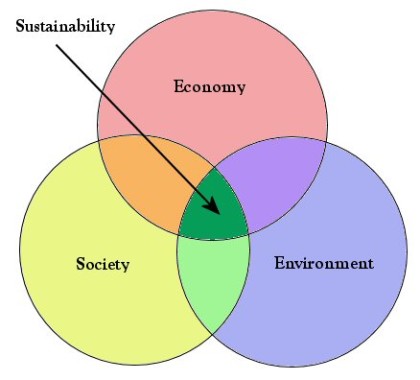‘Sustainability’ must be more than a word
Since the Industrial Revolution humans have set in place trends resulting in excessive global warming, alarming species extinction, air and water pollution, and over-consumption of natural resources, the consequences of which threaten not only the integrity of our environment but our very survival. Sustainability — how to manage consumption of finite resources to provide a viable present and future for ourselves and our children — is now on everyone’s mind.
Sustainability is complicated, and demands a multidisciplinary approach that includes understanding the relationships between economic, social and political systems and how they interface with physical, biological and environmental systems. The Venn diagram shown here conveys this concept simply and clearly.
Sustainability is more than environmentalism. It is about what we do as the controlling species on the planet. We’re becoming less resilient, more fragile, and more susceptible to collapse as has happened to past human civilizations disrupted by climate change, unsafe yields of resources, and social dislocation.
True cost accounting is critical for an honest assessment of our full impacts. A few examples: one cup of coffee has an embedded water requirement (footprint) of 36 gallons; producing a pound of beef requires 2,000 gallons of water; the C02 transportation footprint of the regional tourist and wine industry has yet to be calculated.
The point? The average American consumes far above the world average in resources. Our per capita resource consumption footprint is the true externalized cost borne by the planet and society, which is much larger than the charged price for any good or service. Full accounting means the inclusion of all relevant factors or indicators to calculate true cost. Aquifer decline, for example, is a core indicator in groundwater management.
A growing realization that sustainability is a serious issue is reflected in multiple efforts and programs now taking place in the county: Regional Climate Protection Authority; Transition Sonoma Valley; Climate Action 2020; Sonoma Valley Groundwater Management Program; CA Sustainable Winegrowers Alliance; and Shaping Sonoma Valley 2030, among others. The challenge for us locally is to sync these efforts into a unified focus, using regional true cost accounting.
Because sustainability is multidisciplinary and represents complex systems and interests, each subset of interests tends to be biased to its own needs. Accordingly, people seek to maintain a certain status quo. The first step then, is to effectively define what the problems are and to secure commitments from stakeholders to take collective action.
The rubber meets the road in setting policy. Sustainability policy tends to be some combination of regulatory and incentive-based measures sharing the goal of reducing impacts that contribute to unsustainable trends. Examples of such policy include cap and trade, catch share, carbon offset credits, subsidies for renewable energy, and upstream investment in higher education and living wage ordinances. Education and material wellbeing provide foundations for people to make better ethical, sustainable consumer choices. In this way, social equity generates sustainability. All this sits before the alarming backdrop of unsustainable levels of resource consumption in the U.S.
The course we are on is not adaptive. We need to change the channel — and fast. A true assessment must come to grips with the fact that our regional economy is based on increasingly high levels of resource consumption at the very time we should be conserving more of them. This project won’t be easy.
For the City of Sonoma and Sonoma County, creating a sustainability model using data that accounts for true costs would itself, we believe, be a great start. Frankly, there is no time to lose.




